#Emily Wilding Davison
Text
real statement from my flatmate just now: ‘i hate how much horses crop up in your lore’
#1. SORRY#realised my childhood obsession with emily wilding davison was an immensely worrying indicator for the future.#‘i think it’s more about the horses than it is about you’
8 notes
·
View notes
Text
Emily Davison
Emily Davison, a well-known British suffragette, was born in 1872 in South East London. She was a high achiever who received a scholarship to study literature at Royal Holloway College after graduating from high school. This was cut short when her father died and her mother was unable to pay the tuition expenses. Emily worked as a teacher until she had saved enough money to complete her studies at London University, where she earned a BA. She later spent one term at St Hugh's College, Oxford.
At the time, academia was dominated by men, and Emily developed strong opinions on the limited opportunities available to women in society.
Emmeline Pankhurst's Women's Social and Political Unit (WSPU) piqued Emily's interest, and she soon became a radical member. Emily quickly rose to the position of WSPU head steward, and she quit her job to devote more time and effort to "the Cause." Emily was a suffragette who was discovered lurking in air ducts within the House of Commons, allegedly only listening in on Parliament (she did this three times); she tossed metal balls labelled "bomb" through windows and was taken to prison 6-7 times in four years.
The 1913 Epsom Derby drew tens of thousands of spectators, including King George V and Queen Mary. Anmer, the King's horse, competed in that year's Derby. Anmer was third from last when the horses thundered around Tattenham Corner. Emily had pushed her way through the crowds and slid beneath the guardrail. As Anmer rounded the final corner, he couldn't help but collide with Emily, who was standing in front of him, holding the suffragette flag close to her. Jones was flung from his seat, and the horse fell, only to climb back up and finish the race alone. Jones was injured with broken ribs, bruises, and a concussion. Emily was transported to the hospital, but she died four days later from catastrophic internal injuries.
Thousands of people filled the streets of London for her funeral, which was organised by the WSPU. Her body was then transported to King's Cross Station before being transported to her family's home in Northumberland for burial. Emily was buried in Morpeth, a little distance from her mother's home in Longhorsley, on June 15th, with her mother's inscription "Welcome home the Northumbrian hunger striker" and the WSPU motto "Deeds not words" on her gravestone.
It is still unknown if Emily genuinely planned to commit suicide in the name of the suffragette cause on that fateful day. A return train ticket and an invitation to a suffragette meeting that night were discovered in her handbag, indicating that the act was not planned. However, Emily's prior actions may indicate that she was willing to murder herself for the cause.
Emily was persuaded that a selfless deed would boost the profile of the suffragette movement. This, however, was not the case. The public saw her acts as those of a "mentally ill zealot," and some former supporters of the suffragette movement were so outraged by the episode that they no longer wanted to be linked with "the cause." The media focused on the horse's and jockey's well-being (who never seemed to recover from the shame he felt) rather than the reason Emily died.
https://web.archive.org/web/20170629103230/http://www.historyextra.com/article/premium/suffragette-martyr-emily-davison
8 notes
·
View notes
Text
EMILY DAVISON
Emily Wilding Davison was an English suffragette who fought for votes for women in Britain in the early twentieth century. On 4 June 1913 Davison obtained two flags bearing the suffragette colours of purple, white and green from the WSPU offices; she then travelled by train to Epsom, Surrey, to attend the Derby. She positioned herself in the infield at Tattenham Corner, the final bend before the home straight. At this point in the race, with some of the horses having passed her, she ducked under the guard rail and ran onto the course; she may have held in her hands one of the suffragette flags. She reached up to the reins of Anmer—King George V's horse, ridden by Herbert Jones—and was hit by the animal, which would have been travelling at around 35 miles (56 km) per hour, four seconds after stepping onto the course. Anmer fell in the collision and partly rolled over his jockey, who had his foot momentarily caught in the stirrup. Davison was knocked to the ground unconscious; some reports say she was kicked in the head by Anmer, but the surgeon who operated on Davison stated that "I could find no trace of her having been kicked by a horse". The event was captured on three news cameras.
undefined
youtube
HARVARD REFERENCE
BFL. (2013). THE DERBY 1913. [Online]. YouTube. Last Updated: 30 May 2013. [Accessed 24 October 2022].
2 notes
·
View notes
Text

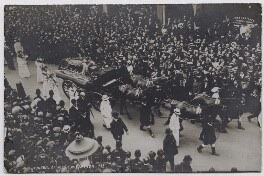
Emily Wilding Davison (1872 – 1913) was an English suffragette in the early 20th century. A member of the Women's Social and Political Union (WSPU) and a militant fighter for her cause, she was arrested on nine occasions, went on hunger strike seven times and was force-fed on forty-nine occasions.
She soon became known in the organisation for her daring militant action; her tactics included breaking windows, throwing stones, setting fire to postboxes, planting bombs and, on three occasions, hiding overnight in the Palace of Westminster—including on the night of the 1911 census.
She died after being hit by King George V's horse Anmer at the 1913 Epsom Derby when she walked onto the track during the race. The WSPU were quick to describe her as a martyr.
5,000 women formed the procession at her funeral, and the route was lined by 50,000 people. Her gravestone bears the WSPU slogan "Deeds not words". She is buried in St Mary the Virgin Churchyard, Northumberland, England.
5 notes
·
View notes
Text
Tutor - Emily Wilding Davison School, Ponteland
We are looking to appoint an outstanding, committed colleague with experience of working with students with SEMH and a desire to form and maintain positive relationships, engaging students in class, and with one-to-one academic and emotional support
Contract Type: Permanent | Working Pattern: Full time - term time plus specified days | Salary: FTE £29,269 - £32,076 (pro-rata £25,250.45 - £27,672.05) | Advert End Date: 07/07/2024 12:00 | http://dlvr.it/T5qzrd
0 notes
Text

Emily Wilding Davison (1872 - 1913), an English suffragette who fought for votes for women in Britain in the early twentieth century. A militant fighter for her cause, she was arrested on nine occasions, went on hunger strike seven times and was force-fed on forty-nine occasions. She died after being hit by King George V's horse at the 1913 Derby when, as a form of protest, she walked onto the track during the race.
ADD INFO RE. THE LONG-TERM DAMAGE CAUSED TO WOMEN'S HEALTH BY FORCE-FEEDING, THE 'CAT & MOUSE' ACT, & THE QUOTE RE. PM ASQUITH BY MP WHOSE NAME I CAN'T REMEMBER *.
The quote is: "You will go down in history as the man who tortured women".
The MP was George Lansbury (Labour) and he was ordered to vacate the House of Commons on a temporary suspension. Afterwards, he received support and praise for his actions and decided to stake his political future on women's suffrage. He resigned his seat in Parliament in 1912 and ran again on the single issue of votes for women. He failed to secure re-election on this occasion, but later went on to become leader of the Labour Party (1932 to 1935).
Herbert Henry Asquith was a member of the Liberal Party and Prime Minister from 1908 to 1916. He took the country into the First World War, but received much criticism and was forced to resign, replaced by David Lloyd George. Acc. to Wikipedia, they became bitter enemies and fought for control of the fast-declining Liberal Party. Also note that while his weaknesses as a war leader and as a party leader after 1914 have been highlighted by historians, his role in creating the modern British welfare state (1906–1911) has been celebrated. ADD INFO RE. HIS ATTITUDES TO WOMEN'S SUFFRAGE.
0 notes
Text
"Kenneth Branagh to Play Boris Johnson in New Pandemic Drama Series"

The article from BBC News covers the announcement that the famous British actor and director, Kenneth Branagh, will play Boris Johnson in a new television drama series about the UK Prime Minister's handling of the COVID-19 pandemic. The five-part series, entitled "This Sceptred Isle," is produced by Sky Atlantic and will focus on the first wave of the pandemic and the government's response to it.
Kenneth Branagh is known for his work in both theatre and film, having directed and starred in several successful adaptations of William Shakespeare's plays, as well as in movies such as "Murder on the Orient Express" and "Dunkirk." He will be joined by an impressive cast, including Olivia Williams as Emily Wilding Davison, a suffragette who died after being hit by the King's horse at the Epsom Derby in 1913.
The series is written by Michael Winterbottom, who previously worked with Steve Coogan on the comedy film "The Trip," and will be produced by Revolution Films. The production team is currently in the process of finalizing the script, and filming is set to begin in early 2022.
The announcement of Branagh's casting has generated a lot of buzz, with many people commenting on how closely he resembles Boris Johnson. It remains to be seen how the series will be received, particularly given the controversy surrounding the UK government's handling of the pandemic. Nevertheless, it is clear that "This Sceptred Isle" is set to be one of the most highly anticipated dramas of the coming year.
Read the full article
0 notes
Text

emily wilding davison
emily wilding davison was born october 18th 1872 and tragically passed june 8th 1913. in 1906 she joined emmeline pankhursts womens social and political union. she quickly stopped her fulltime teaching job and turned her full attention to the wspu as she had become very passionate to the cause and worked closely with pankhurst.
davison is a famous suffragette for her unfortunate death whilst protesting the cause.

this was an idea of protesting that went horrifically wrong. emily was supposed to step out in front of the kings horse and attach a women's rights flag to the horse, instead her and the horse collided and she was left with brain damage and laid unconscious until she unfortunately died. it is also said that the idea was for the horse to kill her to make a point. the suffragettes were not being listened to and the lengths they would go to for their rights were endless. they needed to be taken seriously as humans.
0 notes
Text
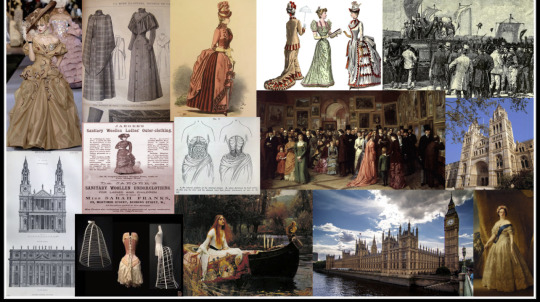

Queen Victoria 1837-1901
Style icon young change the power roles as very men revolved
Many styles can in with her rain
Crinoline originally made from horse hair
Lots of adaptation throughout years on runways
Made for people with lots of money showed wealth due to fabric and size
Bustle
1870 volume not all round just at back again showing wealth
High fashion all handmade
Lots of hats and gloves
Vivienne Westwood did a quirky take on the bustle
Corset
Made of steal damaging to the human body extremely uncomfortable
Silk lined
Corsets never will go out of fashion
Corset was very forced and restrictive
Victorian era travel cam to life
Fabrics and looks where brought over from all over the world
Tea gown 1895
Elegant pre dinner garment to protect clothing
Added kimono sleeve high fashion
Accessory’s made for the middle class to sample the luxury items
End of Victorian period less volume in skirt still very focused On the corset
Queen victory got the white wedding dress in trend but was showing purity but a symbol of wealth as was a dress that could only be worn once and was not the traditional dress
Mourning Victorian period
Queens husband died love of her life and absolutely destroyed her and she went into mourning period for rest of her life
Each class had rules for the mourning period
A women could only re marry if she was in very dyer need of money for her and her children
Mirrors where covered due to the deceased would be in the mirror
No new shoes at the funeral or new anything
And clock in the room they died would been stop at time they died
Charles Fredrick worth
Original haute couture
best fabrics
And had made
Every detail thought at so that the design was beautiful and well made
Heavy tailoring
Mutton sleeve huge shoulders and slim sleeve s
Illustration was the was of advertising and go back and forth for every details
Dress reform and Mrs bloomers
Victorian era was very restrictive the dress reform was against it was wrong to perade women around
Dress movement gone too far the corset with steel damaging to the body
The filth on the dresses due to sewage systems wasn’t around
Amelia bloomer was a suffragettes in America
She was first women to own a vehicle
And promoted the bloomers heavenly in her article still bulky and corset still around
Rational costume
Loose trousers gathered at ankles and women where shown as wild and not proper if was wearing these sort of clothes
The invention of the bicycle was invented and freedom was more open to women now
Trousers was not excepted but women still did
Women with lots of money would be able to get seats with this
Women and sports
Leisure wear was still highly restrictive and has long length skirt and bulky and restrictive
Only the wealthy would participate in these activities
Even skiing they would have to wear skirts and corset
Side saddle only with horse riding
The influence of dress was not to restrict the women in there clothing.
Prostitute to model for them
Very loose and more or a medieval style none restrictive
Inspiration from Greeks Rome gothic Georgian
Gabriel rossetti known for painting with meaning behind them
Suffragette movement
Womens right to vote
Daily mail came up with derogatory name as they thought they was uneducated
Enmeline Pankhurst founded a new organisation in 1903 know as the face of the suffragette very radical and militant
She riled the women up to get the outcome she wanted
The women got sent to prison they was badly treated know as vermin and they would go on Hunger strikes and they force fed them
They tried to put them off but they was so invested nothing put them off standing up
The colours of the suffragette was purple white and green
Emily Davison died for the course for throwing a a banner over the kings horse in the Epsom derby of 5th June 1913 this really opened eyes and ears to these women
As people was now dying for the course
When the war begin they put the campaign aside and started to work in positions for the men as they was at war which was a huge step up but put back down when they got home and the women still fort on for the course for woman’s rights
Development of the new department stores
People starting to make more money so shops started to be developed
The people got dressed up
The clothing still not being bought as like they do today
Not many men went
Mr self ride came from America and opened the first department store and had everything together to create a experience for the people shopping
Fashion magazine
Harpers bizarre
La mode
Vanity fair
Vogue
All illustrated and promoted the clothing that was Coming into style
Sewing machine inverted
Jewish community pathed the way for retail in London and all the way to America
Sewing machine and paper patterns
Past down in generation
0 notes
Text
The Suffragette Movement


The Suffragettes were part of the 'Votes for Women' campaign that had long fought for the right of woman to vote in the UK. To fight for female suffrage they used art, debate, propaganda, attack on property including window smashing and arson.
Suffrage means the right to vote in Parliamentary and general elections.
In 1903, the Woman's Social and Political Union was founded by Emmeline Pankhurst, her daughters, Christabel, Sylvia and Adela Pankhurst, and a small group of women based in Manchester.
For the next 8 years of The Suffragette Movement it was a confrontational struggle, they fought hard to win the vote.
Their headquarters were in London, therefore, they could protest where the government was situated. However, the Suffragettes were treated badly by the government as Emmeline Pankhurst, her daughters Christabel, Sylvia and Adela received prison sentences for their actions.
The Woman's Social and Political Union had not succeeded in achieving the vote, although its campaigning style eased the way for woman to take a more active and public role in society during the war. This role was acknowledged with the granting of Parliamentary vote to a limited number of woman over the age of 30 in 1918.
Harvard Referencing
MUSEUM OF LONDON. (N/A) Who were the Suffragettes? [Online] Available from: https://www.museumoflondon.org.uk/museum-london/explore/who-were-suffragettes. [Accessed: 6th December 2022].
Fig 1. GETTY-CONTRIBUTOR. (N/A) Charlotte Despard, second from right, leads a suffragette march by the National Federation of Women Workers in Bermondsey, London. [Photograph] Available from: https://www.thesun.co.uk/news/5253239/womens-vote-uk-suffragette-movement-representation-people-act/. [Accessed: 6th December 2022].
Fig 2. ALAMY. (N/A) Emily Wilding Davison (1872-1913) died after throwing herself in front of the King's horse at the Derby. [Photograph] Available from: https://www.thesun.co.uk/news/5253239/womens-vote-uk-suffragette-movement-representation-people-act/. [Accessed: 6th December2022].
1 note
·
View note
Text
in hindsight as a kid i was deeply fascinated by the victorian era and its immediate descendants in a way that was quite distinct. jack the ripper, the myth of spring-heeled jack, baby farmers, mudlarks, chimney sweeps, that sketch from horrible histories about nailing a boy’s ear to a factory bench, hulks, sweeney todd, emily wilding davison jumping in front of the king’s horse…. they’re all up here if you look for them. the only skipping song i know is a victorian one about mary ann cotton being hanged for murder
6 notes
·
View notes
Text
SelfMadeHero's No Surrender adapts Constance Maud’s 1911 suffrage novel about English women’s rights
SelfMadeHero's No Surrender adapts Constance Maud’s 1911 suffrage novel about English women’s rights #comics #comicbooks
Constance Maud was at the heart of the British campaign for women’s votes. Her novel No Surrender was published at the height of that struggle and used as a persuasive tool by suffragists. Hailed by Emily Wilding-Davison as “a book which breathes the very spirit of our Women’s Movement”, the fast-paced story interweaves the lives of women from all classes working together to bring about change.…
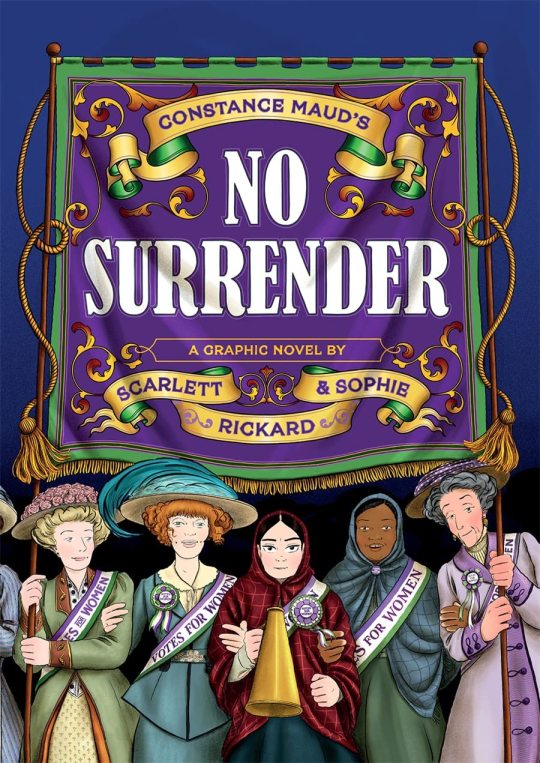
View On WordPress
#constance maud#graphic novel#graphic novels#no surrender#scarlett rickard#selfmadehero#sophie rickard
0 notes
Text
This day in history

I'm on tour with my new, nationally bestselling novel The Bezzle! Catch me TONIGHT (Mar 13) in SAN FRANCISCO with ROBIN SLOAN, then Toronto, NYC, Anaheim, and more!

#20yrsago We can use the power outlets at SXSW now! https://memex.craphound.com/2004/03/14/we-can-use-the-power-outlets-at-sxsw-now/
#10yrsago RIP, Tony Benn https://www.bbc.com/news/uk-politics-26573929
#10yrsago Tony Benn, secret mounter of illegal Parliamentary plaques https://web.archive.org/web/20140222220733/https://www.parliament.uk/about/living-heritage/transformingsociety/electionsvoting/womenvote/case-study-emily-wilding-davison/ewd/tony-benn-plaque/
#10yrsago Vi Hart’s updated poop-on-Pi video https://www.youtube.com/watch?v=5iUh_CSjaSw #10yrsago Zuckerberg phones Obama to complain about NSA spying https://www.facebook.com/zuck/posts/10101301165605491
#5yrsago Walt Disney’s Frozen Head: a science fiction movie secretly shot at Walt Disney World https://www.youtube.com/watch?v=3FYuVU0E7D0
#5yrsago Facebook and Big Tech are monopsonies, even when they’re not monopolies https://www.wired.com/story/facebook-not-monopoly-but-should-broken-up/
#5yrsago A detailed analysis of American ER bills reveals rampant, impossible-to-avoid price-gouging https://www.vox.com/health-care/2018/12/18/18134825/emergency-room-bills-health-care-costs-america

Name your price for 18 of my DRM-free ebooks and support the Electronic Frontier Foundation with the Humble Cory Doctorow Bundle.
3 notes
·
View notes
Text



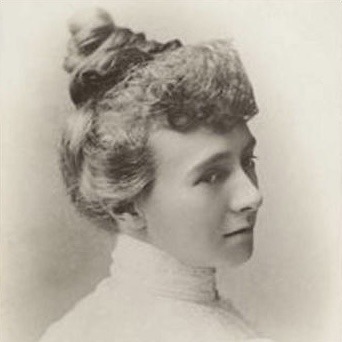
“Emily Wilding Davison was an English suffragette who fought for votes for women in Britain in the early twentieth century.”
“On 4 June 1913 Davison obtained two flags bearing the suffragette colours of purple, white and green from the WSPU offices; she then travelled by train to Epsom, Surrey, to attend the Derby. She positioned herself in the infield at Tattenham Corner, the final bend before the home straight. At this point in the race, with some of the horses having passed her, she ducked under the guard rail and ran onto the course; she may have held in her hands one of the suffragette flags. She reached up to the reins of Anmer—King George V's horse, ridden by Herbert Jones—and was hit by the animal, which would have been travelling at around 35 miles (56 km) per hour, four seconds after stepping onto the course. Anmer fell in the collision and partly rolled over his jockey, who had his foot momentarily caught in the stirrup. Davison was knocked to the ground unconscious; some reports say she was kicked in the head by Anmer, but the surgeon who operated on Davison stated that "I could find no trace of her having been kicked by a horse". The event was captured on three news cameras.”
“Bystanders rushed onto the track and attempted to aid Davison and Jones until both were taken to the nearby Epsom Cottage Hospital. Davison was operated on two days later, but she never regained consciousness; while in hospital she received hate mail. She died on 8 June from a fracture at the base of her skull. Found in Davison's effects were the two suffragette flags, the return stub of her railway ticket to London, her race card, a ticket to a suffragette dance later that day and a diary with appointments for the following week. The King and Queen Mary were present at the race and made enquiries about the health of both Jones and Davison. The King later recorded in his diary that it was "a most regrettable and scandalous proceeding"; in her journal the Queen described Davison as a "horrid woman".”
x
13 notes
·
View notes
Text
Class Teacher (Maternity Cover) - Emily Wilding Davison School
We aim to appoint an experienced KS34 Class Teacher, for maternity cover, who will plan and deliver creative and inspirational lessons across Core Subjects, as well as supporting students who have Social and Emotional Mental Health needs
Contract Type: Fixed Term | Working Pattern: Full time | Salary: Main Scale to UPS (£30,000 - £46,525) | Advert End Date: 19/04/2024 09:00 | http://dlvr.it/T4b1mj
0 notes
Text
Mary de Morgan’s ‘The Wise Princess’: A Victorian Fairy Tale of Feminism and Self-Sacrifice
I’m endlessly fascinated by fairy tales, and what they can tell us about the times they were written in: people’s fears, hopes and ideals. So while I was browsing Project Gutenberg for interesting stories, I stumbled upon Mary de Morgan’s 1880 collection of fairy tales, The Necklace of Princess Fiorimonde and Other Stories. The title story is wild and wonderful - about a princess who does not wish to marry, so turns her suitors into beads and strings them onto a necklace - and deserves a whole post to itself, but the one I want to talk about is the final story in the collection, ‘The Wise Princess’, which moved me to tears when reading it and has stuck with me ever since. (Illustration from the original publication below by Walter Crane.)
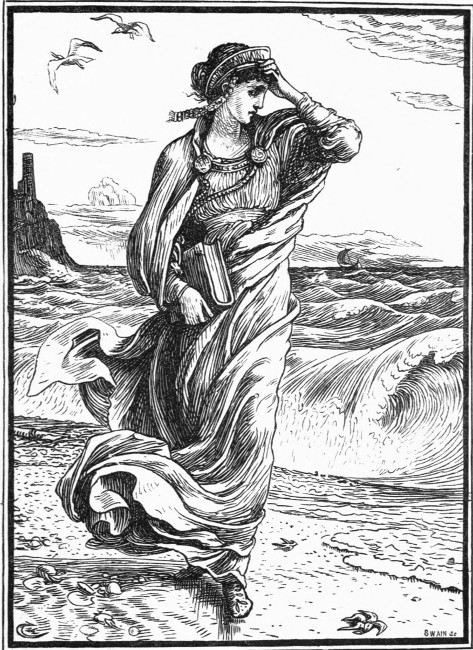
In this story, Princess Fernanda wishes to know everything. After she’s exausted her tutors ‘and learnt every language and every science’, she learns magic from a wizard until 'she knew the languages of all animals. The fishes came from the deep at her call, and the birds from the trees. She could tell when the winds would rise, and when the sea would be still. She could have turned her enemies to stone, or given untold wealth to her friends. But for all that, when she smiled, her lips were very sad, and her eyes were always full of care.’
She asks the wizard how to be happy, but he does not know. She asks her maid, a lark and a dog the same question, but still does not receive a satisfactory answer. (Interestingly, she meets a woman with a baby who says that she is happy, but right at that moment she is anxious because her fisherman husband is late coming home; Princess Fernanda responds, ‘Then you could not teach me.’ I wonder if this is the author’s way of saying that true happiness cannot be dependent on another person, or specifically, that a woman’s happiness cannot be reliant upon a man.)
Then she comes across the body of a young man killed in war, laid out in a church with a smile on his lips. Death, appearing as a white angel, tells her that he taught the soldier how to be happy while the man was doing his duty. Fernanda leaves the church and goes to the beach, where she sees a boy drowning and rushes to save him. She brings him to safety, ‘but the waves were so strong that she could scarcely keep above them. As she tried to seize the rocks, she saw Death coming over the water towards her, and she turned to meet him gladly. “Now,” said he, clasping her in his arms, “I will teach you all you want to know;” and he drew her under the water, and she died.’ When her body is found, cold and beautiful, she too has a smile on her lips.
Mary de Morgan was a feminist and a suffragette - author Kate Forsyth has written a fascinating article about her, titled Suffragette Mary de Morgan: England’s First Feminist Fairy Tale Writer?. This comes through clearly in both this story and others, here with a headstrong princess who wishes - and is allowed - to dedicate herself to studying. This subject was very timely: in 1869, a group of women known as The Edinburgh Seven became the first matriculated undergraduate female students at any British university, having all studied medicine, but they weren’t allowed to graduate or practice as doctors. Their story caught the attention of the press and advocates for women’s education and, four years before the publication of The Necklace of Princess Fiorimonde, the Medical Act 1876 was passed, allowing women to graduate as licensed doctors.
The message of self-sacrifice, too, is strongly Victorian. Stemming from Christian theology, the Victorian view of self-sacrifice as a good and noble act can be seen in the romanticisation of the soldier’s death, as it can be in Memorial to Heroic Self-Sacrifice in Postman’s Park, London, where beautiful tiles - designed by and made by Mary de Morgan’s brother, William de Morgan - commemorate the lives, or rather deaths, of everyday people who died saving others. (If you’ve seen the movie Closer, you’ll know that Natalie Portman’s character takes her name, Alice Ayres, from a plaque here.)

The Victorian ideal of woman as ‘the angel in the house’ - a phrase from a poem by Coventry Patmore in which he describes his perfect wife - was subverted by the suffragettes themselves, who used religious imagery and words such as ‘crusade’ and ‘martyr’ to describe their cause. They often depicted themselves as Joan of Arc figures and portrayed Emily Wilding Davison, who was trampled to death by King George V’s horse in 1913, as an angel on the front cover of their journal.


Although this ideal clearly lasted beyond Queen Victoria’s death in 1901, we can also see the tide beginning to turn against it. Just as the idea that dying in war is a beautiful act was bitterly rebuked by Wilfrid Owen in his poem ‘Dulce et Decorum Est’, written during World War I, a resistance can be found in novels such as May Sinclair’s The Life and Death of Harriet Frean (1922), which shows the devastating consequences of the protagonist’s Victorian upbringing, with its emphasis on selflessness, or E.M. Delafield’s Consequences (1919), where life in a convent causes only more suffering. The Memorial to Heroic Self-Sacrifice was never finished, after its creator George Frederic Watts died in 1904 and his widow lost interest in it.
Although I have conflicted feelings about message in ‘The Wise Princess’, it still moves me. Perhaps it’s because we still haven’t found the answer to ‘how to be happy’, or solved the struggle between caring for others and caring for ourselves.
What do you think about this story? I’d love to know if you have any more examples of fairy tales that reflect their times, examples of Victorian self-sacrifice, or works that rebelled against this ideal - please get in touch!
#mary de morgan#the necklace of princess fiorimonde#fairy tales#victorian fairy tales#feminism#feminist fairy tales#victorian era#suffragettes#emily wilding davison#postman's park#alice ayres#victorian literature
9 notes
·
View notes